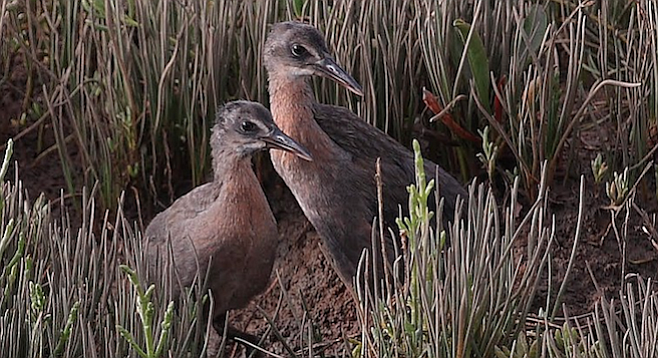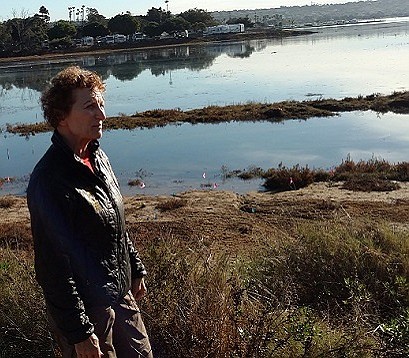 Facebook
Facebook
 X
X
 Instagram
Instagram
 TikTok
TikTok
 Youtube
Youtube

Volunteers with San Diego Audubon used exceptionally high tides Tuesday morning (December 5) as an aid in counting threatened light-footed Ridgway's rails that reside in Kendall-Frost Marsh along the northeast shores of Mission Bay.

"We don't have areas of transitional habitat that are above the highest of high tides — that's what we're trying to create here," explained Isabelle Kay, the marsh's education coordinator and reserve manager, referring to ongoing volunteer work at the site to plant native species along a slope. "This is where the rails should be able to go, but because we've developed right up to the edge of the marsh the birds are forced to use artificial nesting platforms."
King tides, the largest of the year, push the Ridgway's rails (chicken-sized birds that rarely take flight) up onto higher ground, making them easier to count. Kay says that while there were as many as 36 nesting pairs spotted two years ago, there might be only 8 or 9 pairs remaining.
"This marsh isn't big enough to build a population to the point that when we have fluctuations in conditions they can be extricated — the population can go basically to zero. That's why we need larger areas to sustain a population."
Supporters of expanding the habitat area will have a chance to speak out tonight, as the Mission Bay Park Committee meets to consider redevelopment options for the De Anza Cove, a former mobile-home park. Previous meetings on the topic have left both preservationists and the RV owners competing for the space dissatisfied.
"Mission Bay is supposed to balance commerce, recreation, and the environment. For the majority of the bay's existence the focus has been on commerce and recreation. This northeast corner is supposed to be the environmental piece, where wildlife can thrive," said Rebecca Schwartz Lesberg, an organizer with ReWild Mission Bay.
The high tides in effect on Tuesday, Schwartz Lesberg says, are indicative of normal conditions in the coming decades as sea levels continue to rise, meaning more habitat will be needed to replace that which will become permanently submerged.
"The plans are not sustainable to sea-level rise. As sea levels rise, very important parts of Mission Bay will flood," Schwartz Lesberg continued. "San Diego Audubon is not the only group unhappy with these plans, which really don't maximize public access. And this isn't an example of a situation where if everyone is upset you know you have a good compromise, this is a situation where everyone's upset because these are bad plans."
The Mission Bay Park Committee meets at 6 p.m. Tuesday night (December 5th) in the Mission Bay High School auditorium.


Volunteers with San Diego Audubon used exceptionally high tides Tuesday morning (December 5) as an aid in counting threatened light-footed Ridgway's rails that reside in Kendall-Frost Marsh along the northeast shores of Mission Bay.

"We don't have areas of transitional habitat that are above the highest of high tides — that's what we're trying to create here," explained Isabelle Kay, the marsh's education coordinator and reserve manager, referring to ongoing volunteer work at the site to plant native species along a slope. "This is where the rails should be able to go, but because we've developed right up to the edge of the marsh the birds are forced to use artificial nesting platforms."
King tides, the largest of the year, push the Ridgway's rails (chicken-sized birds that rarely take flight) up onto higher ground, making them easier to count. Kay says that while there were as many as 36 nesting pairs spotted two years ago, there might be only 8 or 9 pairs remaining.
"This marsh isn't big enough to build a population to the point that when we have fluctuations in conditions they can be extricated — the population can go basically to zero. That's why we need larger areas to sustain a population."
Supporters of expanding the habitat area will have a chance to speak out tonight, as the Mission Bay Park Committee meets to consider redevelopment options for the De Anza Cove, a former mobile-home park. Previous meetings on the topic have left both preservationists and the RV owners competing for the space dissatisfied.
"Mission Bay is supposed to balance commerce, recreation, and the environment. For the majority of the bay's existence the focus has been on commerce and recreation. This northeast corner is supposed to be the environmental piece, where wildlife can thrive," said Rebecca Schwartz Lesberg, an organizer with ReWild Mission Bay.
The high tides in effect on Tuesday, Schwartz Lesberg says, are indicative of normal conditions in the coming decades as sea levels continue to rise, meaning more habitat will be needed to replace that which will become permanently submerged.
"The plans are not sustainable to sea-level rise. As sea levels rise, very important parts of Mission Bay will flood," Schwartz Lesberg continued. "San Diego Audubon is not the only group unhappy with these plans, which really don't maximize public access. And this isn't an example of a situation where if everyone is upset you know you have a good compromise, this is a situation where everyone's upset because these are bad plans."
The Mission Bay Park Committee meets at 6 p.m. Tuesday night (December 5th) in the Mission Bay High School auditorium.
Comments